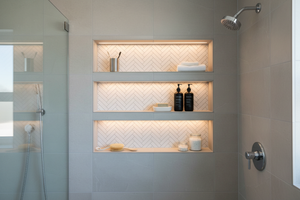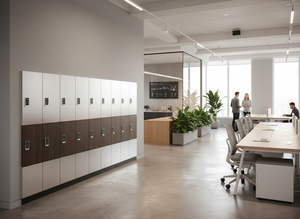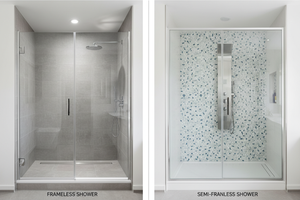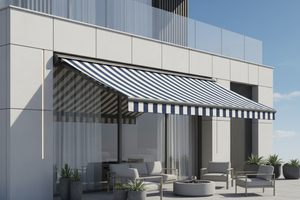Types of Shower Screens: Full Guide to Modern Bathroom Solutions (2025)

If you’re planning a bathroom upgrade, one of the first things to consider is your shower. And that’s where the types of shower screens come in. The right choice doesn’t just stop water from splashing everywhere—it also shapes how your bathroom looks, feels, and functions day to day.
Increasingly, Australian homeowners are opting for screens that seamlessly blend modern style with practicality. In this guide, we’ll break down the main types of shower screens so you can determine which one best suits your bathroom renovation plans.
Top 10 Types of Shower Screens for Modern Bathrooms
1. Framed Shower Screens

Framed shower screens feature comprehensive aluminium frameworks that surround glass edges, providing maximum structural support and reliable water containment. These traditional, fully framed shower screens accommodate thinner glass panels while maintaining safety standards through robust metal extrusions that effectively distribute stress loads.
The design philosophy prioritises functional performance and cost-effectiveness over contemporary aesthetics, making framed systems suitable for rental properties, budget-conscious renovations, or installations where long-term durability is paramount. The continuous framework provides multiple sealing surfaces against water infiltration, making them highly effective at preventing leaks.
Construction typically involves 4mm to 6mm toughened glass held within aluminium channels that are powder-coated in various finishes, including white, chrome, or bronze. The comprehensive framing system allows for field adjustments during installation, accommodating less-than-perfect wall conditions that might challenge other screen types.
While framed screens may lack the visual refinement of contemporary alternatives, they offer distinct advantages, including simplified maintenance protocols, readily available replacement parts, and proven long-term reliability in high-usage applications.
2. Semi-Frameless Shower Screens

Semi-frameless shower screens occupy the middle ground between fully framed and frameless options, incorporating slim aluminium frameworks around glass perimeters while maintaining much of the visual appeal associated with premium designs. These hybrid semi-frameless screens typically use 6mm to 8mm toughened glass glazed into minimal metal channels.
The selective application of framing elements allows semi-frameless screens to achieve contemporary aesthetics while maintaining simplified installation procedures and moderate pricing. This approach makes them particularly suitable for renovation projects where budget optimisation remains important without compromising style.
Manufacturing involves precision-cut glass panels fitted into streamlined aluminium extrusions that provide necessary structural support while minimising visual impact. The reduced framework eliminates many of the areas that characterise soap scum accumulation in fully framed shower screens. Semi-frameless screens provide the perfect balance between affordability and modern appeal.
Maintenance requirements fall between frameless and fully framed alternatives, as the minimal framing requires periodic cleaning attention while offering improved accessibility compared to comprehensive framing systems. The cost-effectiveness makes semi-frameless systems attractive for property developers and homeowners seeking a modern appearance without a premium investment.
3. Frameless Shower Screens

Frameless shower screens represent the premium tier of modern bathroom design, featuring minimal hardware and thick, toughened glass that creates uninterrupted visual experiences. These systems rely on 10mm frameless shower screen glass that complies with Australian Standards AS-NZS2208, ensuring both structural integrity and safety requirements.
The absence of traditional metal framing around glass edges creates the illusion of expanded space, making frameless screens particularly valuable in compact bathrooms. Our 90x90cm Corner Frameless Shower Screen exemplifies this approach, featuring solid brass hinges with 180-degree operation and matte black powder-coated aluminium channels.
Construction methodology involves precision-engineered shower screen hardware, including specialised hinges, wall channels, and mounting systems designed to support the substantial weight of thick glass panels. The hardware must accommodate thermal expansion, building settlement, and operational stresses while maintaining water-tight seals.
Low-maintenance characteristics stem from reduced surfaces where soap scum and mineral deposits typically accumulate. However, installation requires careful attention to wall preparation and structural reinforcement, as the thicker glass panels place greater demands on mounting points compared to framed alternatives. A completely frameless design offers the ultimate in minimalist aesthetic for contemporary bathrooms.
4. Sliding Door Shower Screens

Sliding door shower screens operate along horizontal tracks, eliminating clearance requirements associated with swing-style doors while providing space-efficient access to shower areas. These sliding door systems are particularly suited to small bathrooms with limited floor space, as the sliding door operates parallel to the openings rather than projecting into the bathroom area.
Our Adjustable 900x1100mm Double Sliding Door Glass Shower Screen demonstrates this efficiency, featuring precision-manufactured track assemblies and rolling hardware designed for smooth, quiet operation over extended periods.
The bypass capability of multiple panels allows for various opening configurations, depending on access requirements, while maintaining water containment when portions remain closed. This flexibility makes sliding door shower systems adaptable to different user preferences and bathroom layouts.
Track systems require regular maintenance, including debris removal and lubrication of components, to ensure continued smooth operation. Hardware selection becomes critical, as tracks, rollers, and guides must withstand moisture and temperature conditions while supporting substantial glass panel weights. A sliding door shower provides excellent functionality in the same space as traditional opening mechanisms.
Installation considerations include ensuring proper track alignment, adequate drainage around track areas, and accessibility for ongoing maintenance procedures. Quality sliding systems incorporate adjustable components that accommodate building settlement and thermal movement.
5. Pivot Door Shower Screens
Pivot door shower screens allow panels to rotate from single corners, typically accommodating up to 180-degree movement in both directions. This operational flexibility addresses spatial constraints where traditional hinged doors prove impractical due to bathroom layout or fixture placement.
The structural advantages include uninterrupted frameless views when pivot hardware attaches at door corners, eliminating visual obstructions that might detract from overall aesthetic appeal. Floor-to-ceiling mounting reduces the complexity of glass fabrication while providing superior stability compared to traditional side-hung systems.
Pivot doors incorporate self-centring mechanisms that automatically position doors within specific angles, often featuring automatic closure from predetermined positions. This functionality enhances water containment while providing user convenience during regular operation.
However, pivot door systems require adequate clearance space for proper operation. They may result in water dripping onto bathroom floors when doors open, especially if they have residual moisture on their glass surfaces. The concentrated stress loads on pivot hardware demand careful selection and professional installation to ensure long-term reliability.
6. Bi-Fold Shower Screens
Bi-fold shower screens feature panels that fold inward along central hinges in two or more folds, creating compact opening profiles that maximise accessibility within limited bathroom spaces. These systems are particularly suited to narrow shower openings, where traditional swing doors would compromise floor space or interfere with bathroom fixtures.
The folding mechanism typically incorporates multiple hinges and alignment systems that ensure smooth operation while maintaining structural integrity. Quality bi-fold systems feature magnetic catches or friction hinges that securely hold the panels in an open position, allowing for easy use during showers. This opening mechanism requires precise engineering to function reliably within the designated space required for proper operation.
Installation complexity increases compared to standard hinged doors due to the multiple moving components and precision alignment requirements. However, the space-saving benefits often justify the additional complexity in bathrooms where every centimetre of floor space contributes to functionality.
Maintenance attention focuses on hinge mechanisms and alignment systems that may require periodic adjustment to maintain proper operation. The multiple folding surfaces also create additional areas requiring regular cleaning to prevent soap buildup.
7. Corner Shower Screens / Neo-Angle Shower Screens

Corner shower screens maximise space efficiency by utilising two perpendicular walls as structural support while adding glass panels for complete enclosure. These configurations create square or rectangular shower stalls that optimise corner space utilisation in small bathrooms.
Neo-angle configurations feature angled outer corners that reduce projection into bathroom floor space while providing adequate interior shower dimensions. This geometric approach can add approximately 1.5 square feet to available bathroom floor area compared to standard rectangular enclosures. Quadrant shower screens offer another corner solution with curved profiles that save space in awkward spaces.
Our corner shower screen collections demonstrate this versatility, featuring combinations of hinged panels and fixed screens that create seamless corner enclosures. The design flexibility accommodates various panel arrangements, ranging from simple two-panel systems to complex configurations incorporating multiple fixed panels and specialised doors.
Installation considerations include precise angular measurements and specialised hardware designed to accommodate non-standard geometries. Water containment becomes particularly important at angular intersections where multiple sealing points must coordinate effectively through accurate installation.
8. Fixed Panel Shower Screens (Walk-In)
Fixed panel shower screens create walk-in shower experiences without traditional door mechanisms, relying on strategic glass placement to contain water while providing completely open access. These fixed panel systems work particularly well in larger bathrooms where floor space allows generous shower openings.
The design approach emphasises minimal hardware requirements while maximising visual openness and easy access. Fixed panel installations typically require larger floor drainage areas and careful consideration of showerhead placement to prevent water from escaping beyond contained areas.
The simplicity of installation makes fixed-panel shower systems attractive for renovation projects; however, proper waterproofing and drainage remain critical for achieving successful, long-term performance. The absence of moving parts eliminates ongoing maintenance requirements associated with hinges, tracks, or sealing mechanisms.
However, water containment depends entirely on shower design and drainage capacity, requiring careful planning to prevent water damage to surrounding bathroom areas. Professional consultation ensures adequate drainage and proper placement of glass panels for effective water management.
9. Frosted Glass & Textured Glass Options
Frosted and textured glass treatments provide enhanced privacy while maintaining light transmission, preserving an open bathroom feel. These surface treatments can be incorporated into any shower screen frame type, offering design flexibility for various aesthetic preferences.
Frosted glass treatments create opaque surfaces that diffuse light for soft, even illumination while completely obscuring visibility through glass panels. These treatments can be applied to entire panels or incorporated into specific sections for desired privacy levels while maintaining clear viewing areas.
Textured glass options include rain patterns that create cascading waterfall effects, fluted designs that provide vertical movement characteristics, and geometric textures that add visual interest while obscuring direct visibility. Popular Australian patterns include bamboo, reed, and pebble textures that complement natural design themes.
10. Custom Shower Screens

Custom shower screen solutions address unique bathroom configurations that standard products cannot accommodate. These bespoke systems incorporate precise measurements, specialised hardware, and a tailored installation process to meet specific architectural requirements.
Our curved shower screen options represent one aspect of customisation, featuring radius glass panels that soften angular bathroom geometries while providing space-efficient enclosure solutions. The 100x100cm rounded sliding curved shower screen exemplifies this approach, featuring 6mm curved glass and chrome finishes.
Custom fabrication processes involve detailed site measurement, engineering analysis, and precision manufacturing to ensure proper fit and function within unique spaces. Lead times typically extend beyond standard products due to individual design and manufacturing requirements.
How Shower Screens Impact Your Bathroom Layout
The selection of appropriate shower types has a significant impact on bathroom functionality and spatial perception. Frameless shower systems create visual continuity, making spaces appear larger, while the strategic use of clear glass maintains sight lines that prevent visual fragmentation in compact areas.
Corner installations maximise floor space utilisation by transforming unused corners into functional shower areas. This approach is particularly beneficial for compact Australian bathrooms, where every square metre contributes to overall functionality and user comfort. The right shower panel selection can create extra space and a more spacious perception through clean lines and minimalist design.
Sliding door mechanisms eliminate door swing clearances, allowing fixtures and fittings to be placed closer to shower openings. This space efficiency can free up valuable floor area for additional storage, improved traffic flow, or enhanced accessibility features.
Additionally, walk-in configurations with fixed panels create seamless transitions between the shower area and the bathroom, contributing to open-plan bathroom design concepts that emphasise spatial continuity. However, these designs require careful drainage planning and adequate floor space to function effectively.
How To Upgrade Your Bathroom With A New Shower Screen
-
Assess existing conditions
- Inspect the plumbing, drainage, and wall structure before making any upgrades.
- Frameless systems may need stronger wall reinforcement compared to framed installations.
-
Match with existing bathroom elements
- Consider tiles, fixtures, and colour schemes when choosing a screen.
- Matte black finishes are on-trend and provide a timeless look.
- Plan whether the screen will be installed with a shower tray or directly onto the floor.
-
Account for waterproofing requirements
- Upgrades may be needed when switching from framed to frameless systems.
- Altering shower opening dimensions can also require new waterproofing.
- Australian building standards mandate proper waterproofing behind shower areas.
-
Prioritise professional installation
- Ensures compliance with building standards and long-term durability.
- Provides warranty protection for both materials and workmanship.
- Qualified installers understand structural needs and waterproofing details.
-
Plan your budget carefully
- Include not just the cost of the shower screen, but also:
- Potential wall or structural modifications
- Waterproofing upgrades
- Tile repairs or replacements
- Include not just the cost of the shower screen, but also:
FAQs
What are the drawbacks of frameless shower screens?
Frameless shower screens require a higher upfront investment due to thicker glass requirements and specialised hardware. Installation demands greater precision and may require wall reinforcement to support heavier glass panels. While maintenance is simplified, the absence of protective framing requires more careful handling during cleaning to prevent damage to glass edges.
What are the different types of shower door glass?
Australian shower doors utilise toughened safety glass in various thicknesses, ranging from 6mm to 10mm, all of which comply with relevant standards. Options include clear glass for maximum visibility, frosted treatments for privacy, textured surfaces with patterns such as rain or fluted designs, and low-iron glass that eliminates greenish tints for enhanced clarity and colour accuracy. Shower screen glass specifications must meet strict safety requirements.
What is the Australian standard for shower screens?
Australian shower screens must comply with safety glazing standards and installation requirements. These standards mandate the use of toughened glass, specify minimum thicknesses based on panel dimensions and support configurations, require proper certification marking, and ensure compliance with human impact safety requirements to provide user protection.
What are the different types of shower wall panels?
Shower panel options include traditional ceramic tiles, composite materials such as acrylic or fibreglass, natural stone options like marble or travertine, glass panels for seamless integration with screens, and modern polymer systems. Each offers different maintenance requirements, water resistance levels, and aesthetic appeal that coordinate with various types of shower screen designs.
How do I choose between sliding and hinged shower doors?
Choose sliding screens for bathrooms with limited floor space where door swing clearance is restricted, or when you prefer easy access without door interference. Select hinged doors when you want traditional operation, have adequate clearance space, and prefer the sealing advantages that hinged doors often provide. Consider your mobility needs and bathroom traffic patterns when making this decision.
Can I install shower screens myself?
While some basic framed systems may suit experienced DIY enthusiasts, professional installation is recommended for frameless screens, complex configurations, or when structural modifications are required. Professional installation ensures compliance with Australian building codes, proper waterproofing, and warranty coverage that protects your investment.
Final Note
Understanding the various types of shower screens enables informed decisions that strike a balance between aesthetic appeal and practical requirements, taking into account budget constraints. Frameless screens offer a premium appearance and easier maintenance, but require a higher investment and careful installation. In contrast, traditional framed systems deliver reliable performance at budget-friendly costs.
Successful shower screen selection requires considering bathroom layout, usage patterns, accessibility needs, and long-term design goals. Professional consultation ensures compliance with building standards while achieving desired aesthetic and functional outcomes that enhance both daily use satisfaction and property value.
The investment in FactoryFast's quality shower screens pays dividends through improved bathroom functionality, enhanced visual appeal, and reduced maintenance requirements over the system's lifespan. Choose systems that complement your overall bathroom design while meeting practical needs for safety, accessibility, and water containment.
Citations:
[1] https://www.regalshowerscreens.com/frameless-vs-semi-frameless-vs-framed-shower-screens/
[2] https://www.showerlagoon.com/pivot-vs-sliding-glass-doors-which-one-should-you-choose/
[3] https://www.elegantshowers.com.au/blogs/news/shower-glass-thickness-explained-is-6mm-8mm-or-10mm-right-for-your-bathroom
[4] https://www.fairtrading.nsw.gov.au/trades-and-businesses/construction-and-trade-essentials/building-products/toughened-glass
 1300 760 441
1300 760 441 cs@factoryfast.com.au
cs@factoryfast.com.au





